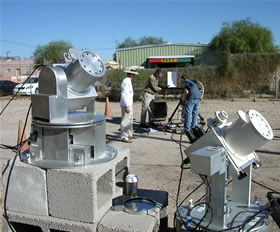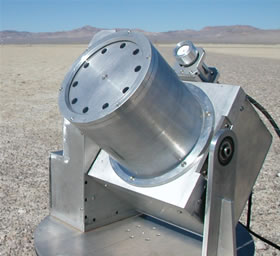Atmospheric
Atmospheric Research
Determining the composition of the atmosphere has long been an important aspect of the research of the Remote Sensing Group. The group’s effort in atmospheric measurement originated in the need to determine the inputs to the vicarious calibration methods for which the RSG is well known. The atmospheric measurements rely on solar extinction measurements at mulitple wavelengths. The solar radiometer is relatively calibrated in a Langley method scheme that also provides atmospheric optical depths that are related to total column amounts of atmospheric components. The spectral nature of the optical depths can be used to determine aerosol properties such as sizes and to determine models for the atmosphere that allow predictions of atmospheric scattering and absorption at arbitrary wavelengths.
The vicarious calibration work has since led to improved instrumentation developed in the RSG’s facilities as well as interest in measuring the atmosphere as part of the solar-radiation-based calibrations and monitoring atmospheric composition in Tucson and at the RSG test sites. Such monitoring work has been done periodically at the University of Arizona since the mid 1970s when King, et al. used direct solar measurements from 57 days in Tucson, Arizona to analyze types of size distributions found for different times of the year in the period 1975 1977. Early work also included a study of seasonal trends in aerosol optical depth values with the maximum found to be in the fall and late spring and minimum in the late fall and early summer. Aerosol size results (in terms of an Angstrom coefficient) indicated that aerosol sizes in Tucson are larger on average than other locations (Angstrom values ranged from 0.2 to 1.2). Subsequent work in the 1980s and more currently have shown a shift to more smaller particles and an overall increase in the amount of aerosols. The monitoring work has also allowed the evaluation of several forest fire and dust scenarios.
An improvement in the ability to monitor atmospheric conditions is a result in the RSG’s participation in a more global approach to aerosol monitoring as part of the Aeronet federation of Cimel Sunphotometers. This has allowed for studies of large numbers of locations based on specific source regions and expected aerosol types including Tucson as well as several of the RSG’s test sites. The overall behavior of aerosols in the atmosphere remains a difficult problem in atmospheric science and thus an area of active research for the RSG.

The primary instrument used for the measurements of the transmitted irradiance is an automated solar radiometer (ASR) was also used for comparison in the background study. The radiometer was developed at the University of Arizona and consists of ten silicon photodiode/op amp detectors each with an interference filter, nominally at 380, 400, 440, 520, 610, 670, 780, 870, 940, and 1030 nm. These instruments are colloquially known as the “Reagan” sun photometers and are similar in design to that used in the 1975 study. The radiometer is fully automated once set up with a data collection rate determined by the user at set up. Characteristics of the instrument are described in detail by Ehsani, et al.
A secondary instrument used by RSG is a Cimel sun/sky photometer as a part of the AERONET global network. The characteristics of the Cimel are summarized here and are described in further detail by Holben, et al. The Cimel has eight spectral bands nominally at 340, 380, 440, 500, 670, 870, 940, and 1020 nm. Direct sun measurements are made every 15 minutes. Data are transmitted via satellite and processed at the Goddard Space Flight Center and are then made available via the AERONET website. Processing of the direct measurements includes an automated cloud screening technique and other quality assessments.
Additional atmospheric instrumentation are available for more detailed studies, but the solar radiometers are the workhorse of the RSG’s measurement capabilities. Improvements continue on these instruments to include measurements at longer wavelengths, better thermal stabilization, and measurement of ancillary data (such as pressure, temperature, and time). The sensors have become more robust over time improving the repeatability of the data sets. The goal of this work is to ensure that the instruments themselves do not play a role in increasing the uncertainties of the RSG’s calibration work while at the same time allowing RSG scientists to continue efforts to understand the atmosphere itself.

